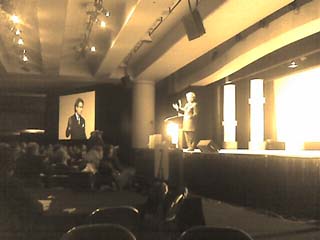trade
event
 |
Men have just one operating system with one switch that goes "on" and "off". Beer, "on". Work, "off". Sex, "on". Nagging, "off".
Women are a more complex machine, with multiple operating systems containing switches marked "on", "off", "maybe", "a little", "not too much" and multiple ways of executing their programs. New switches are added regularly and the operating systems change without warning.
As a result, when men shop, we know what we want, get it, and leave the store. Women enter, browse, discover, and it can last indefinitely. "Honey, what are you getting?" Wife: "I don't know". Husband, "Who long do you need". Wife: "a few minutes". Husband (3 hours later): "Honey, are you done?" Wife: "No, not yet".
These operating systems are based on the theory of 3 brains: the Cortex, which logically tells men we only shop when we need something; the Emotional brain, which successfully fights the urge to shop (or spend, for some of us) with the urge to watch the game. And then there's the Reptile brain, which processes our most basic survival needs, and explains why men become intolerable when women take them shopping.
As you may have guessed, women's brains operate somewhat in reverse: they need to shop, justifying it emotionally, triumphant when they calculate savings from a sale.
These theories are not mine, but a Dr. G. Clotaire Rapaille's, a psychologist who spoke as a keynote guest of IBM at this Tuesday's (January 18, 2005) NRF conference. The scenario above was his (I summarized) and his explanation was much more entertaining (I was literally in tears with laughter.)
 |
His research, much like our own, attempts to understand the forces that impact behavior and consequently, how consumers spend their time and money. His work has been employed by almost every major brand to improve their products and services. Everything from the service you receive at the Ritz-Carlton to the smell of your Folgers originated from his research.
But how can you use these insights in your business?
Most of his research and theories arrive at the same answer: enhancing service. If that requires retraining and conditioning, so be it. If that requires changing product attributes, so be it. If that requires scrapping your entire business model, so be it. From a financial standpoint (not to mention political), this isn't feasible for every company. However, if you're smaller than the companies our good doctor has worked with, then it must become your prerogative to initiate change now, before it becomes cost-prohibitive. Don't forget that employee turnover will also make it easier to affect change as your company grows.
If you're a larger company, it is recommended you become your own customer
and go through what they go through incognito. The experience will serve as
a powerful basis for your incentive to re-deploy your resources, no matter whose
feelings get hurt in the process, to alter the experience. In the long-run,
nothing negative can come of it, for, as my accountant told me when he informed
me of how much I'd end up paying in payroll taxes for a year, if I can't pay
them, I shouldn't be in business. Thus, if you can't afford to make a change
when necessary, you shouldn't be in business, either.
Write to Al Berrios
at editor@alberrios.com
Related alberrios.com Sections
Disclaimer:
The recommendations, commentary and opinions published herein are based on
public information sometimes referenced via hyperlinks. Any similarities or
likeness to any ideas or commentary from any other sources not referenced
is purely coincidental. al berrios & co. cannot control any results occurring
from advice obtained from this publication nor any opinion(s) conveyed by
any reader of this publication.
(c) 2005. All Rights Reserved. al berrios & company, inc. Published
by al berrios & co. This Report may not be reproduced or redistributed
in any form without written permission from al berrios & co., subject
to penalty.